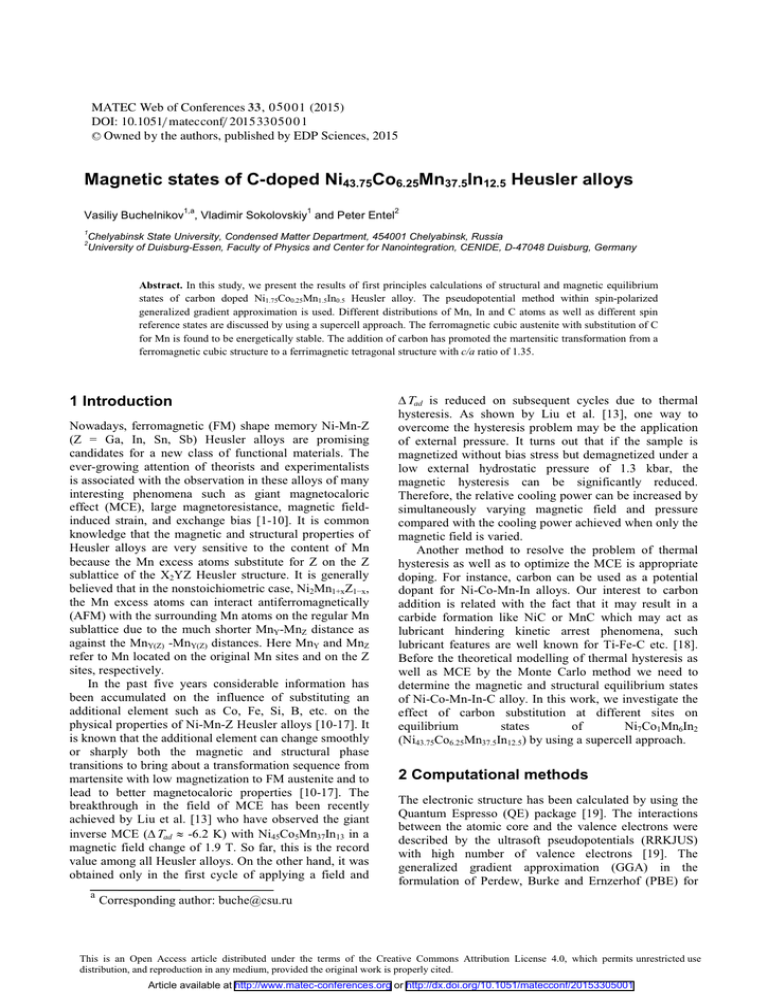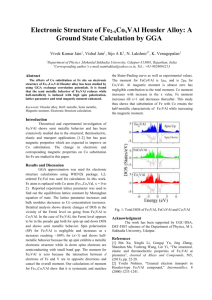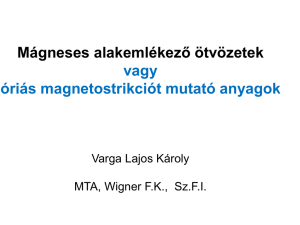Magnetic states of C-doped Ni Co Mn In
advertisement

MATEC Web of Conferences 33 , 0 5 0 0 1 (2015)
DOI: 10.1051/ m atec conf/ 201 5 33 0 5 0 0 1
C Owned by the authors, published by EDP Sciences, 2015
Magnetic states of C-doped Ni43.75Co6.25Mn37.5In12.5 Heusler alloys
1,a
1
2
Vasiliy Buchelnikov , Vladimir Sokolovskiy and Peter Entel
1
Chelyabinsk State University, Condensed Matter Department, 454001 Chelyabinsk, Russia
University of Duisburg-Essen, Faculty of Physics and Center for Nanointegration, CENIDE, D-47048 Duisburg, Germany
2
Abstract. In this study, we present the results of first principles calculations of structural and magnetic equilibrium
states of carbon doped Ni1.75Co0.25Mn1.5In0.5 Heusler alloy. The pseudopotential method within spin-polarized
generalized gradient approximation is used. Different distributions of Mn, In and C atoms as well as different spin
reference states are discussed by using a supercell approach. The ferromagnetic cubic austenite with substitution of C
for Mn is found to be energetically stable. The addition of carbon has promoted the martensitic transformation from a
ferromagnetic cubic structure to a ferrimagnetic tetragonal structure with c/a ratio of 1.35.
1 Introduction
Nowadays, ferromagnetic (FM) shape memory Ni-Mn-Z
(Z = Ga, In, Sn, Sb) Heusler alloys are promising
candidates for a new class of functional materials. The
ever-growing attention of theorists and experimentalists
is associated with the observation in these alloys of many
interesting phenomena such as giant magnetocaloric
effect (MCE), large magnetoresistance, magnetic fieldinduced strain, and exchange bias [1-10]. It is common
knowledge that the magnetic and structural properties of
Heusler alloys are very sensitive to the content of Mn
because the Mn excess atoms substitute for Z on the Z
sublattice of the X2YZ Heusler structure. It is generally
believed that in the nonstoichiometric case, Ni2Mn1+xZ,
the Mn excess atoms can interact antiferromagnetically
(AFM) with the surrounding Mn atoms on the regular Mn
sublattice due to the much shorter MnY-MnZ distance as
against the MnY(Z) -MnY(Z) distances. Here MnY and MnZ
refer to Mn located on the original Mn sites and on the Z
sites, respectively.
In the past five years considerable information has
been accumulated on the influence of substituting an
additional element such as Co, Fe, Si, B, etc. on the
physical properties of Ni-Mn-Z Heusler alloys [10-17]. It
is known that the additional element can change smoothly
or sharply both the magnetic and structural phase
transitions to bring about a transformation sequence from
martensite with low magnetization to FM austenite and to
lead to better magnetocaloric properties [10-17]. The
breakthrough in the field of MCE has been recently
achieved by Liu et al. [13] who have observed the giant
inverse MCE ('7ad | -6.2 K) with Ni45Co5Mn37In13 in a
magnetic field change of 1.9 T. So far, this is the record
value among all Heusler alloys. On the other hand, it was
obtained only in the first cycle of applying a field and
a
'7ad is reduced on subsequent cycles due to thermal
hysteresis. As shown by Liu et al. [13], one way to
overcome the hysteresis problem may be the application
of external pressure. It turns out that if the sample is
magnetized without bias stress but demagnetized under a
low external hydrostatic pressure of 1.3 kbar, the
magnetic hysteresis can be significantly reduced.
Therefore, the relative cooling power can be increased by
simultaneously varying magnetic field and pressure
compared with the cooling power achieved when only the
magnetic field is varied.
Another method to resolve the problem of thermal
hysteresis as well as to optimize the MCE is appropriate
doping. For instance, carbon can be used as a potential
dopant for Ni-Co-Mn-In alloys. Our interest to carbon
addition is related with the fact that it may result in a
carbide formation like NiC or MnC which may act as
lubricant hindering kinetic arrest phenomena, such
lubricant features are well known for Ti-Fe-C etc. [18].
Before the theoretical modelling of thermal hysteresis as
well as MCE by the Monte Carlo method we need to
determine the magnetic and structural equilibrium states
of Ni-Co-Mn-In-C alloy. In this work, we investigate the
effect of carbon substitution at different sites on
equilibrium
states
of
Ni7Co1Mn6In2
(Ni43.75Co6.25Mn37.5In12.5) by using a supercell approach.
2 Computational methods
The electronic structure has been calculated by using the
Quantum Espresso (QE) package [19]. The interactions
between the atomic core and the valence electrons were
described by the ultrasoft pseudopotentials (RRKJUS)
with high number of valence electrons [19]. The
generalized gradient approximation (GGA) in the
formulation of Perdew, Burke and Ernzerhof (PBE) for
Corresponding author: buche@csu.ru
This is an Open Access article distributed under the terms of the Creative Commons Attribution License 4.0, which permits XQUHVWULFWHGXVH
distribution, and reproduction in any medium, provided the original work is properly cited.
Article available at http://www.matec-conferences.org or http://dx.doi.org/10.1051/matecconf/20153305001
MATEC Web of Conferences
the representation of the exchange-correlation functional
was used [20]. The structural optimizations are performed
using the Broyden-Fletcher-Goldfarb-Shanno algorithm
[19]. The Kohn-Sham orbitals were described using a
plane-wave basis set. An energy cut-off of 80 Ry was
used to truncate the plane-wave expansion of the
electronic wave functions. The charge-density cut-off was
kept at 12.5 times that of the kinetic energy cut-off and
the Methfessel-Paxton smearing size was fixed at 5 mRy.
In the calculations we used automatically generated
uniform k-point grid similar to Monkhorst-Pack grids.
The modeling parameters are calculated after an energy
convergence of 0.01 mRy. The Brillouin zone integration
was carried out using smearing with Methfessel-Paxton
first-order spreading. A denser k-point mesh of 83
and ”smearing” and ”tetrahedra” occupations mode were
used for the lattice relaxation and tetragonal distortion
calculations, respectively.
In order to determine the magnetic ground state and
equilibrium lattice parameter of carbon doped Ni-Co-MnIn alloy in the austenite, the energy calculations were
carried out using a 16-atom supercell of the
Ni7Co1Mn6In1C1 alloy. Here, three situations of atomic
distribution of MnY(Z), In and C atoms were considered,
(Fig. 1). In the first and second cases (Figs. 1(a, b)), one
MnY atom at the centre of the cubic cell replaces by C
and goes to either of two In sites. As the result, in the first
case C has two nearest neighbours (nn) MnZ and three
next nearest neighbours (nnn) MnY atoms. For second
case, C has two nn MnY and three nnn MnZ atoms,
respectively. Finally, in the third case (Fig. 1(c)), one In
atom replaces by C atom. We denoted described atomic
distributions as follows: C(2nnMnZ), C(3nnMnZ) and
C(In), respectively. It should be noted that other atomic
distributions would be equivalent to these ones.
which all magnetic moments of Ni, Co MnY and MnZ
atoms are positive. The second one was a ferrimagnetic
(FIM) phase with the positive magnetic moments of Ni,
Co and MnY atoms and the negative magnetic moment of
MnZ atoms.
3 Results and discussions
In the first step, the lattice constants were determined for
different spin configurations. The total energies as
functions of the lattice parameter and tetragonal c/a ratio
for both FM and FIM states are calculated and presented
in Figs. 2 and 3.
Let us first discuss the lattice relaxation calculations.
As can clearly be seen from Fig. 2, the FM austenite with
C(2nnMnZ) atomic configuration is found to be more
stable in energy compared with other cases although the
small difference in energy (| 10 meV/f.u.) between the
FM austenite with C(In) and C(2nnMnZ) atomic
distributions. It has be pointed out that the carbon
addition in Ni7Co1Mn6In2 alloy results in a decrease in
equilibrium lattice parameter from a0 | 5.96 Å (C 0 at.%)
up to 5.85 Å (C 6.25 at.%). The value of 5.96 Å has been
estimated theoretically from ab initio relaxation
calculations presented in Refs. [21, 22].
Figure 2 . (Color online) The variation of the total energy per
formula unit (f.u. - 4 atoms) of Ni7Co1Mn6In1C1 alloy for
different supercells with FM and FIM spin configurations. Here,
E0 is the equilibrium total energy for the FM C(2nnMnZ) atomic
configuration. Results for FM and FIM orders are depicted by
lines with filled and open symbols, respectively.
The equilibrium lattice constants and bulk moduli of
cubic C-doped Ni7Co1Mn6In2 alloy calculated for
different supercells and spin configurations are listed in
Table 1. Here, the lattice parameter was derived by
minimizing the total energy while the bulk modulus has
been calculated from the double derivative of the total
energy (E), by using the following equation.
Figure 1. (Color online) Three types of 16-atom supercells for
off-stoichiometric Ni7Co1Mn6In1C1 Heusler alloy were used.
Here (a) C(2nnMnZ) (b) C(3nnMnZ) and (c) C(In) are different
atomic distributions.
Two magnetic configurations for the energy calculations
were also considered. The first one was the FM state, in
= = (1)
Here V0 is the equlibrium volume, P and V are the
external pressure and the cell volume, respectively.
05001-p.2
ESOMAT 2015
Table 1. Equilibrium lattice parameters and bulk moduli of the
cubic C-doped Ni7Co1Mn6In2 alloy with different spin reference
states.
Compound
spin
order
a0
(Å)
B
(GPa)
M
(P
P%f.u.)
Ni7Co1Mn6In2
FM
5.969
136.95
6.825
Ni7Co1Mn6In2
FIM
5.961
134.02
2.365
C(In)
FM
5.845
144.92
6.893
C(In)
FIM
5.825
139.53
2.342
C(2nnMnZ)
FM
5.848
145.62
6.933
C(2nnMnZ)
FIM
5.824
140.23
0.4
C(3nnMnZ)
FM
5.855
148.17
7.02
C(3nnMnZ)
FIM
5.838
141.3
0.097
Concerning the bulk modulus, it can be seen from
Table 1 that it increases with decreasing of the lattice
parameter due to the carbon addition in Ni7Co1Mn6In2
alloy. The largest bulk modulus (B | 148.17 GPa) is
found for the FM austenite with C(3nnMnZ) atomic
distribution. With respect to the total magnetic moment, it
is seen from Table 1 that the carbon doping leads to an
increase (decrease) in the magnetic moment of FM (FIM)
austenite, respectively. Small values of magnetic moment
obtained for FIM austenite with C(2nnMnZ) and
C(3nnMnZ) atomic distributions are due to the increase of
atoms
interacting
with
MnY
atoms
MnZ
antiferromagnetically. It should be noted that the
equilibrium lattice parameter and magnetization
determined with ab initio calculations reported in Table 1
are in good agreement with experimental data [13].
Using the equilibrium lattice parameter and keeping a
constant volume, the variation of the total energy as a
function of tetragonal distortion of Ni7Co1Mn6In1C1 alloy
with C(In) and C(2nnMnZ) atomic configurations are
presented in Fig. 3(a, b). In order to see the effect of C on
martesitic phase transition in a C-doped NiCoMnIn alloy,
the energy curve calculated for the Ni7Co1Mn6In2
composition is also presented in Fig. 3(c).
From Fig. 3(a), it can be seen that there are two
energy minima at c/a = 0.95 and 1.33 for the FIM spin
configuration in Ni7Co1Mn6In1C1 alloy with C(2nnMnZ)
atomic distribution. With respect the FM alignment, we
can observe only one energy minimum at c/a ratio of
0.97. On the other hand, in the case of Ni7Co1Mn6In1C1
alloy with C(In) atomic distribution (Fig. 3(b)), it is seen
that there is one energy minimum at c/a of 1.19 (FM
state) and 1.35 (FIM state). Finally, in the case of
Ni7Co1Mn6In2 alloy, the FM austenite is energetically
favorable as compared with the FIM martensite, which
has the energy minimum at c/a ratio of 1.25. Evidently,
the carbon addition stimulates the martensitic phase
transformation in composition Ni7Co1Mn6In2 at a Co
content of 6.25 at.%. We would like to note that in case
of
NiCoMnIn
compositions,
the
martensitic
transformation occurs experimentally at smaller content
of Co [10]. In general, the substitution of (6.25 at.%) C
and Co for Mn and Ni results in the martensitic
transformation from FM cubic austenite to FIM
tetragonal martensite due to the fact that the energy
difference between the austenitic and martensitic
structures is large for both compositions (See, Fig. 3(a,
b)).
Figure 3. (Color online) Relative variation of the total energy as
a function of the tetragonality in Ni7Co1Mn6In1C1 alloy with (a)
C(2nnMnZ) and (b) C(In) atomic configurations and (c)
Ni7Co1Mn6In2 alloy. Zero energy corresponds to the energy of
the L21 structure in each case.
The total magnetic moments in martensitic phases
with FM and FIM spin alignments in dependence on the
carbon substitution in NiCoMnIn alloys are listed in
Table 2.
05001-p.3
MATEC Web of Conferences
Table 2. Total magnetic moments in the martensitic states of Cdoped Ni7Co1Mn6In2 alloy with different spin reference states.
Education and Science of Russian Federation (RF) No
3.2021.2014/K (Section 3). PE acknowledges DFG (SPP
1599) for financial support.
Compound
spin
order
c/a
M
P%f.u.)
(P
Ni7Co1Mn6In2
FIM
1.25
2.13
References
C(In)
FM
1.19
6.63
1.
C(In)
FIM
1.33
2.07
C(2nnMnZ)
FM
0.97
6.88
C(2nnMnZ)
FIM
1.35
0.39
2.
3.
As can be seen from Table 2, the smallest magnetization
is found in the FIM martensite with C(2nnMnZ) atomic
distribution. The small value of magnetization is related
with a shorter distance between MnY and MnZ atoms
interacting antiferromagnetically. Besides, the number of
MnZ atoms in the composition with C(2nnMnZ) atomic
distribution is greater by one than in the composition with
C doped for In. Comparing with the results obtained for
Ni7Co1Mn6In2 alloy, it is seen that the largest difference
in magnetization between austenite and martensite is
realized with the carbon doping for Mn. Therefore, better
magnetocaloric properties can be expected.
4.
5.
6.
7.
8.
9.
4 Summary
In this work the equilibrium magnetic and structural
ground states of C-doped Ni7Co1Mn6In2 composition
have been studied by means of the ab initio calculations
in combination with the supercell approach. Three
supercells with different spin configurations and different
substitution of C for In and Mn atoms have been
considered. It has been shown that the addition of carbon
leads to an appearance of martensitic transformation from
FM austenite to FIM martensite. Comparing the results
obtained from the lattice relaxation calculations, it was
showed that the FM austenite with C(2nnMnZ) atomic
configuration has the minimum energy although the FM
austenite with C doped for In is very close in energy with
the first one. The decrease (increase) in the equilibrium
lattice parameter (bulk modulus) was found with carbon
addition due to smaller atomic radius of carbon,
respectively. Concerning the magnetic moment, it has
been shown that the magnetization change between FM
austenite and FIM martensite with C(2nnMnZ) atomic
configuration is 6.49 PB/f.u. As a result, large
magnetocaloric properties can be expected in the C-doped
NiCoMnIn system. Additional calculations with the help
of Monte Carlo technique of magnetic and
magnetocaloric properties as well as thermal hysteresis in
C-doped NiCoMnIn system would be needed.
10.
11.
12.
13.
14.
15.
16.
17.
18.
Acknowledgments
19.
This work is supported by RFBR Grant No. 14-02-01085,
RSF No. 14-12-00570\14 (Section 2), Ministry of
20.
05001-p.4
A.N. Vasiliev, V.D. Buchelnikov, T. Takagi, V.V.
Khovailo and E.I. Estrin, Physics-Uspekhi 46, 559
(2003)
T. Krenke, M. Acet, E.F. Wassermann, X. Moya, Ll.
Manosa, A. Planes, Nature Mater. 4, 450 (2005).
R. Kainuma, Y. Imano, W. Ito, Y. Sutou, H. Morito,
S. Okamoto, O. Kitakami, K. Oikawa, A. Fujita, T.
Kanomata, K. Ishida, Nature 493, 957 (2006)
A. Planes, Ll. Manosa, Mater. Sci. Forum 512, 145
(2006).
V.D. Buchelnikov, A.N. Vasiliev, V.V. Koledov,
S.V. Taskaev, V.V. Khovaylo, V.G. Shavrov,
Physics – Uspechi 49, 871 (2006)
M. Khan, I. Dubenko, S. Stadler, N. Ali, J. Phys.
Condens. Matter 20, 235204 (2008)
A. Planes, Ll. Manosa, M. Acet, J. Phys. Condens.
Matter 21, 233201 (2009)
V.D. Buchelnikov, and V.V. Sokolovskiy, Phys.
Metal. Metallogrh. 112, 633 (2011).
P. Entel, M.E. Gruner, A. Hutch, A. Dannenberg, M.
Siewert, H.C. Herper, T. Kakeshita, T. Fukuda, V.V.
Sokolovskiy, V.D. Buchelnikov, in Disorder and
Strain-Induced Complexity, Functional Materials
vol. 148 ed. by T. Kakeshita, T. Fukuda, A. Saxena,
A. Planes (Springer, Berlin, 2012).
V.V.
Sokolovskiy,
M.A.
Zagrebin,
V.D.
Buchelnikov, in Shape Memory Alloys: Properties,
Technologies, Opportunities vol. 81-82, ed. by N.
Resnina, V. Rubanik (Mater. Sci. Foundation, TTP,
Pfaffikon, 2015).
R. Das, S. Sarma, A. Perumal, A. Srinivasan, J.
Appl. Phys. 109, 07A901 (2011)
D.Y. Cong, S. Roth, L. Shultz, Acta Mater. 60, 5335
(2012)
J. Liu, T. Gottshall, K. Skokov, J.D. Moore, O.
Gutfleisch, Nature Mat. 11, 620 (2012)
I. Dubenko, T. Samanta, A. Quetz, A. Kazakov, I.
Rodionov, D. Mettus, V. Prudnikov, S. Stadler, P.
Adams, J. Prestigiacomo, A. Granovsky, A. Zhukov,
N. Ali, Appl. Phys. Lett. 100, 192402 (2012).
I. Dubenko, T. Samanta, A.K. Pathak, A. Kazakov,
V. Prudnikov, S. Stadler, A. Granovsky, A. Zhukov,
N. Ali, J. Magn. Magn. Mater. 324, 3530 (2012).
R.Y. Umetsu, D. Kikuchi, K. Koyama, K. Watanabe,
Y. Yamaguchi, R. Kainuma, T. Kanomata, J. Alloys
Comp. 580, 506 (2013)
S. Fabbrici, G. Porcari, F. Cugini, M. Solzi, J.
Kamarad, Z. Arnold, R. Cabassi, F. Albertini,
Entropy 16, 2204 (2014)
K. Das, T.K. Bandyopadhyay, S. Das, J. Mater. Sci.
37, 3881 (2002)
Quantum ESPRESSO package Version 5.02 (2014)
at http://www.pwscf.org
J.P. Perdew, K. Burke, M. Enzerhof, Phys. Rev. Lett.
77, 3865 (1996)
ESOMAT 2015
21. P. Entel, M.E. Gruner, D. Comtesse, V. Sokolovskiy,
V. Buchelnikov, Phys. Status Solidi B 251, 2135
(2014)
22. V.D. Buchelnikov, V.V. Sokolovskiy, M.A.
Zagrebin, M.A. Tufatullina, P. Entel, J. Phys. D:
Appl. Phys. 48, 164005 (2015)
05001-p.5




